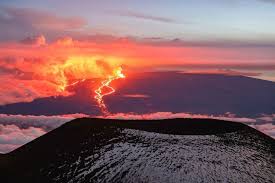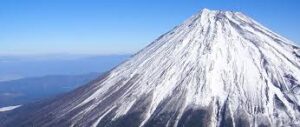Volcanoes are among the most awe-inspiring natural phenomena on Earth. Their sheer size, explosive power, and the role they play in shaping our planet make them a subject of endless fascination. This article explores astonishing facts about the world’s largest volcanoes, offering insights into their immense scale, unique features, and the incredible geological processes behind them.

1. Mauna Loa: The Giant of the Pacific

1.1. The Largest Volcano by Volume
Mauna Loa, located on the Big Island of Hawaii, is the largest volcano on Earth by volume. Rising to 13,681 feet (4,170 meters) above sea level, it extends deep beneath the ocean, making its total height around 30,000 feet (9,144 meters) from base to summit. Its massive size covers an area of about 2,035 square miles (5,271 square kilometers).
- Surprising Fact: Mauna Loa is so large that it actually causes the Earth’s crust to bend downward. This phenomenon, known as subsidence, results from the immense weight of the volcano.

1.2. Eruption History
Mauna Loa has erupted 33 times since its first well-documented eruption in 1843. Its eruptions are typically less explosive than those of other volcanoes due to the fluid nature of its lava, which allows gases to escape more easily.
- Surprising Fact: The lava from Mauna Loa can travel at speeds of up to 60 miles per hour (97 kilometers per hour) during an eruption, creating dramatic and fast-moving lava flows.
2. Shield Volcanoes: The Formative Type
2.1. Characteristics of Shield Volcanoes
The world’s largest volcanoes are primarily shield volcanoes, characterized by their broad, gently sloping sides and fluid lava flows. These volcanoes, such as Mauna Loa and Kilauea, are built up by successive lava eruptions that spread out in all directions.
- Surprising Fact: Shield volcanoes have relatively low viscosity lava that flows easily, allowing them to cover vast areas and form their broad shapes. This is in contrast to stratovolcanoes, which have more explosive eruptions due to their more viscous lava.

2.2. Examples of Shield Volcanoes
In addition to Mauna Loa, other notable shield volcanoes include Kilauea on the Big Island of Hawaii and Olympus Mons on Mars, the tallest volcano in the solar system.
- Surprising Fact: Olympus Mons is nearly three times the height of Mount Everest, standing at about 69,000 feet (21,000 meters) tall, due to the lack of tectonic plate movement on Mars.
3. Tamu Massif: The Undersea Giant
3.1. The Largest Volcano on Earth by Area
Tamu Massif, located in the northwest Pacific Ocean, is the largest single volcano on Earth by area. It covers approximately 120,000 square miles (310,000 square kilometers), making it more extensive than the island of Great Britain.
- Surprising Fact: Despite its massive size, Tamu Massif was only discovered in 2013, when scientists mapped the seafloor and realized the enormous extent of this undersea volcano.

3.2. Formation and Characteristics
Tamu Massif is a shield volcano, formed by repeated lava flows that spread out from a central vent. Its formation occurred between 145 and 75 million years ago, during the Cretaceous period.
- Surprising Fact: Tamu Massif is so large that its summit is located 2.5 miles (4 kilometers) below the ocean surface, demonstrating the immense scale of volcanic activity beneath the waves.
4. Kilauea: The Most Active Volcano
4.1. Continual Activity
Kilauea, also located on the Big Island of Hawaii, is one of the most active volcanoes in the world. It has been erupting almost continuously since 1983, making it a focal point for volcanologists and tourists alike.
- Surprising Fact: The lava from Kilauea has created new land by flowing into the ocean and solidifying, contributing to the growth of the Hawaiian Islands.

4.2. Cultural and Scientific Importance
Kilauea holds significant cultural importance for Native Hawaiians and is also a vital site for scientific research. Its eruptions provide valuable insights into volcanic processes and the dynamics of lava flow.
- Surprising Fact: The volcano’s summit crater, Halemaʻumaʻu, is home to the goddess Pele in Hawaiian mythology, and its eruptions are considered a manifestation of her fiery presence.
5. Mount Fuji: The Iconic Peak

5.1. Cultural Significance
Mount Fuji, standing at 12,388 feet (3,776 meters), is Japan’s highest peak and one of the most iconic volcanoes in the world. Its nearly perfect conical shape and snow-capped summit make it a symbol of Japan and a major tourist attraction.
- Surprising Fact: Mount Fuji is an active stratovolcano, with its last major eruption occurring in 1707. Despite its long dormancy, it remains a significant threat due to its proximity to Tokyo and other major cities.

5.2. Climbing and Tourism
Mount Fuji is a popular climbing destination, with thousands of hikers ascending its slopes every year. The climbing season is typically from July to September, when the weather is more favorable.
- Surprising Fact: The ascent of Mount Fuji is considered a pilgrimage by many climbers, reflecting its deep cultural and spiritual significance.
Conclusion
The world’s largest volcanoes offer a glimpse into the dynamic and powerful forces shaping our planet. From the immense size of Mauna Loa and Tamu Massif to the cultural significance of Mount Fuji, these volcanoes captivate with their scale, activity, and the mysteries they hold. Whether beneath the ocean or towering above it, these natural giants continue to influence the world in profound and astonishing ways.

